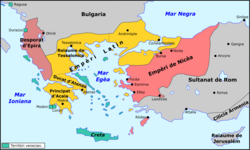
Back Keurajeuën Latin ACE Latynse Ryk Afrikaans Lateinisches Kaiserreich ALS Imperio Latino de Costantinoble AN الإمبراطورية اللاتينية Arabic الامبراطوريه اللاتينيه فى قسطنطينيه ARZ Imperiu llatín AST Latın imperiyası Azerbaijani لاتین ایمپراتورلوغو AZB Лацінская імперыя Byelorussian
Latin Empire Imperium Constantinopolitanum Imperium Romaniae Imperium Romanorum | |||||||||||||||
|---|---|---|---|---|---|---|---|---|---|---|---|---|---|---|---|
| 1204–1261[note 1] | |||||||||||||||
 The Latin Empire with its vassals (in yellow) in 1204 | |||||||||||||||
| Capital | Constantinople | ||||||||||||||
| Common languages | Latin, Old French (official) Greek (popular) | ||||||||||||||
| Religion | Latin Catholic (official) Greek Orthodox (popular) | ||||||||||||||
| Government | Feudal Christian Monarchy | ||||||||||||||
| Emperor | |||||||||||||||
• 1204–1205 | Baldwin I | ||||||||||||||
• 1206–1216 | Henry | ||||||||||||||
• 1216–1217 | Peter | ||||||||||||||
• 1219–1228 | Robert I | ||||||||||||||
• 1229–1237 | John | ||||||||||||||
• 1228–1261 | Baldwin II | ||||||||||||||
| Historical era | High Middle Ages | ||||||||||||||
| 1204 | |||||||||||||||
• Joint Nicean-Bulgarian campaign against Empire | 1235 | ||||||||||||||
• Disestablished | 1261[note 1] | ||||||||||||||
| Area | |||||||||||||||
| 1204 est.[2] | 179,000 km2 (69,000 sq mi) | ||||||||||||||
| 1209 est.[2] | 206,000 km2 (80,000 sq mi) | ||||||||||||||
| 1228 est.[2] | 47,000 km2 (18,000 sq mi) | ||||||||||||||
| 1260 est.[2] | 14,000 km2 (5,400 sq mi) | ||||||||||||||
| |||||||||||||||
| Today part of | Turkey Greece Bulgaria | ||||||||||||||
The Latin Empire was a feudal crusader state. It was created during the Fourth Crusade on the land captured from the Byzantine Empire. Originally, the crusaders were told to retake the Muslim-controlled city of Jerusalem. Instead of doing that, the crusaders looted and captured Constantinople.
Cite error: There are <ref group=note> tags on this page, but the references will not show without a {{reflist|group=note}} template (see the help page).
- ↑ Hubert de Vries, Byzantium: Arms and Emblems (hubert-herald.nl) (2011).
- ↑ 2.0 2.1 2.2 2.3 Matanov, Hristo (2014). В търсене на средновековното време. Неравният път на българите (VII - XV в.)(in Bulgarian). IK Gutenberg. ISBN 9786191760183.
© MMXXIII Rich X Search. We shall prevail. All rights reserved. Rich X Search
![Attributed arms[note 2] of Latin Empire](http://upload.wikimedia.org/wikipedia/commons/thumb/8/84/Arms_of_Courtenay-Constantinople.svg/85px-Arms_of_Courtenay-Constantinople.svg.png)